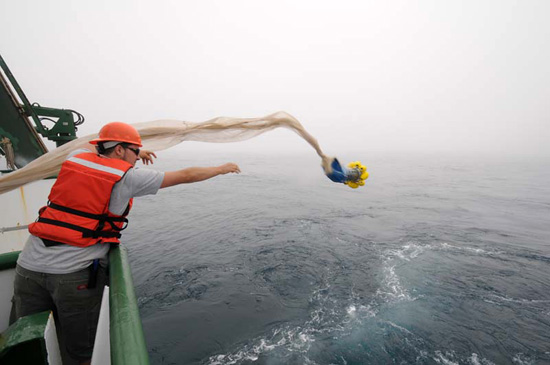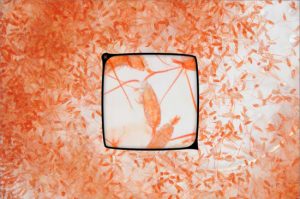June 9 – Chasing Fish
3:00 p.m. Japan Time
Station 9; 38N, 147E
We had one good net haul after sunset yesterday and had a second around midnight cancelled due to weather that the biologists were sad to miss. Then early this morning, as soon as the sun came up, the net came back almost empty.

Justin Smith from the University of Hawaii’s Ocean Technology Group heaves the sample collection container for the Methot net off the stern of the R/V KOK. (Photo by Ken Kostel, Woods Hole Oceanographic Institution)
What we were seeing is almost certainly tied to one of the greatest migrations on Earth, one that happens every day all over the world, but (unlike the African savannah) one that goes on largely unnoticed and beyond the view of National Geographic cameras. Every night, countless small fish and zooplankton rise to the surface to feed on the tiny phytoplankton that lives in the upper ocean within reach of sunlight. As soon as the sun rises these animals all descend to darker waters looking for shelter from larger predators.
It’s difficult for the biologists on board to see their empty nets, to know what’s happening, and to not go chasing deeper after more fish. As Hannes Baumann said, “You want to adapt, but you have to be consistent. You want the nets to be full. It’s also hard to just say ‘That’s the way it is.’”

After this post was finished, the Bongo nets came back filled with an unexpected bounty of pink copepods (Eucalanus spp.) (Photo by Ken Kostel, Woods Hole Oceanographic Institution)
I may have mentioned this earlier in a caption, but Hannes and Jennifer George from SUNY Stony Brook are working with Jun Nishikawa and Hiroomi Miyamoto from Tokyo University to do the biological surveys on this cruise. They have three nets at their disposal: the “small net” that gets clamped onto the top 100 meters of the CTD wire to collect phytoplankton in the upper ocean, the Bongo net that collects larvae and other animals larger than one-third of a millimeter, and the Methot net, which brings in juvenile fish, shrimp, and big plankton about 4 millimeters and larger.
The phytoplankton samples are filtered and will be analyzed for chlorophyll content back on land. The Bongo and Methot net samples are divided, with ninety percent destined to be freeze-dried and ground up for radiochemical measurements back at Stony Brook and for additional, more labor-intensive analysis at Oregon State University. The remaining ten percent will be identified for species composition and distribution by our Japanese colleagues, who have particular expertise in what lives in these waters.
From that, the various groups involved will be able to assemble a picture of how productive these waters are and what and how much lives here. Comparing this to the amount and type of radioactive isotopes we find in the water will then tell more about how much of which substances is actually being assimilated into and passed among the lower levels of the food chain.
As with the chemistry, however, much of the biological analysis will also need to wait until we return to shore. Many of the tests that will be run have to be done in ultra-clean facilities over a period of weeks and months or require instruments that we could not take to sea.
Observationally, it appears that sometime during the night we crossed a line—from the warmer waters of the southern North Pacific to the colder, nutrient-rich northern waters that help make this area one of the most productive fisheries in the world. Where the two water masses meet and mix, large predators like tuna tend to congregate so they can make quick forays across the boundary to feed on medium-size fish that live in colder waters.
Jennifer is seeing signs of this transition in sharp increases in phytoplankton. We’ll see if the trend continues in the nets that will be going out over the next couple of hours.
The cold water has also created dense fog, and as we approach our final station on this leg, we are surrounded by a wall of white. One lone bird—possibly an albatross—circles the ship, dipping in and out of the fog with barely any effort while we labor away with nets and bottles and winches.